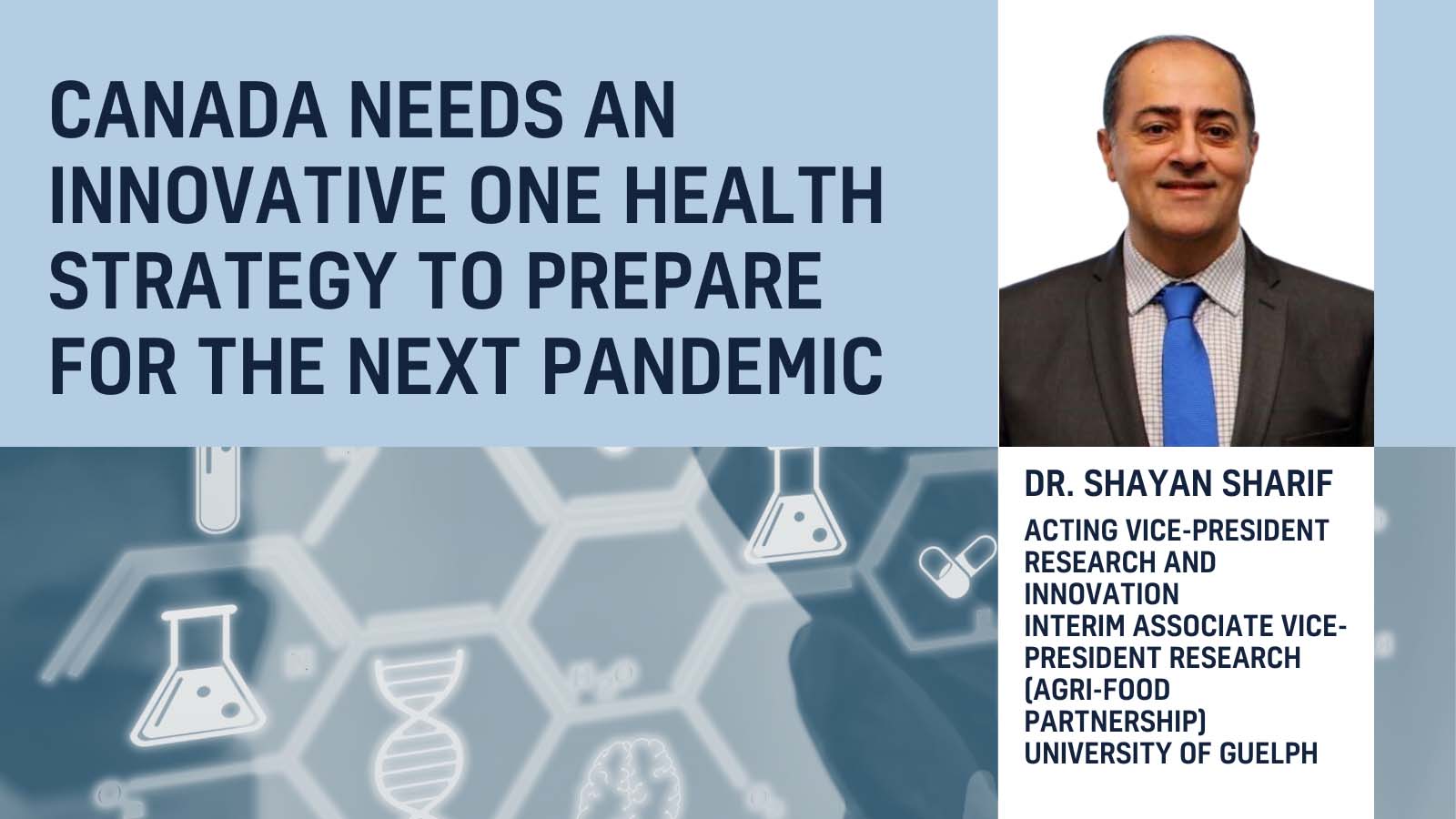Canada Needs An Innovative One Health Strategy To Prepare For The Next Pandemic

Author(s):
Dr. Shayan Sharif
Acting Vice-President Research and Innovation
University of Guelph
Interim Associate Vice-President Research (Agri- Food Partnership)
Disclaimer: The French version of this text has been auto-translated and has not been approved by the author.
As the world emerges from the devastating COVID-19 pandemic, we must prepare for the growing danger posed by other zoonotic diseases transmitted from animals to humans. Avian influenza is of particular concern as the unprecedented levels circulating in wild birds and domestic poultry across Canada set the stage for a future pandemic that could dwarf the impacts of COVID-19. To transform our ability to get ahead of emerging zoonotic threats like avian influenza, Canada needs to embrace a One Health approach that breaks down the silos separating human, animal and environmental health.
A perfect storm brewing: The threat of avian influenza
Since the current highly pathogenic strain of avian influenza, H5N1, was first reported in Canada in 2021, over 420 domestic poultry outbreaks have been reported across the nine provinces,1 leading to the culling of over 11 million birds. The impact on wildlife has been equally devastating, with cases spanning all provinces and territories, affecting a wide range of species, including waterfowl, seabirds, and raptors. Massive die-off’s have been observed, signalling a profound disturbance in our ecosystems.
Yet, the true gravity of the situation extends beyond these alarming statistics. What is most concerning about the current outbreak is the unprecedented level of viral activity and its ability to spill over into different mammal species, including dogs and cats, bears, foxes, and seals in Canada, and dairy cows in the US. These events signal the possibility of the virus adapting to mammalian hosts and increasing risk of human transmission. If the virus acquires the ability to transmit efficiently among humans, we will be facing another global pandemic –with very high mortality rates.
A One Health strategy is critical to combat future pandemics
To effectively prepare for future pandemics, Canada must embrace the proven One Health strategy of integrating human, animal and environmental health. One Health is a well-tested discipline that emphasizes the mutually dependent relationships between these three pillars. The strategy is responsible for many of our biggest successes in fighting infectious disease, including managing rabies by controlling the disease in wildlife environments. By cohesively merging research, surveillance, policies, and practices across human, animal and environmental health, we can develop a holistic understanding of zoonotic disease risks much earlier and coordinate interventions to reduce spillover into humans and subsequent spread.
A One Health lens on the avian influenza outbreak quickly reveals how aspects of the human-animal-environment interface have converged to create a tinderbox situation. Climate change is upending traditional migration patterns of wild birds, which act as virus reservoirs, increasing contact between infected wild populations and domestic poultry operations. Meanwhile, avian influenza is rapidly undergoing genetic changes and spilling over into new mammalian hosts, potentially evolving greater human transmissibility.
At the same time, long-standing underinvestment in animal health research leaves livestock and poultry industries ill-equipped to contain outbreaks. Once avian influenza spills over to poultry operations, birds must be culled at huge economic cost. The resulting shortage and price hikes for poultry products compound broader food insecurity issues also driven by climate change, supply chain disruptions and political unrest. The health and economic repercussions quickly spillover to human populations.
Despite the clear interconnected risks, we remain stuck in the reactive responses and siloed thinking that allowed COVID-19 to spiral. Fragmented governance and lack of sustained funding leave animal health drastically under-prioritized compared to human health. Meanwhile, emerging pathogen surveillance systems within the human and animal health sectors remain disconnected from one another. With so many biological, environmental and socio-economic ingredients converging, we face the risks of an avian influenza-sparked pandemic if we fail to take decisive action now.
How One Health can ensure long-term success
Applying a One Health lens to zoonotic diseases would catalyze badly needed innovations in pandemic preparedness. Linked surveillance systems spanning human, animal and environmental monitoring would provide earlier warning of concerning developments with emerging zoonotic diseases like avian influenza. Multidisciplinary research and data-sharing across human and veterinary medical fields, ecology, biology, epidemiology, Indigenous knowledge systems and social sciences would yield a deeper understanding and more holistic risk assessment of drivers of zoonotic disease.
Critically, a One Health approach demands policy coordination across the siloed domains of public health, agriculture, natural resources, transportation, and more – all of which shape the human-animal-environment interactions that allow viruses to flourish. Rather than disjointed responses by individual jurisdictions and sectors, a One Health strategy would focus resources through a unified action plan for mitigating zoonotic disease outbreaks. Furthermore, by recognizing the intrinsic value of wildlife health and the ecosystems we share, we can forge stronger partnerships with Indigenous communities, whose traditional knowledge and practices are invaluable in preserving biodiversity and mitigating environmental threats.
To address the need for a One Health approach, we have proposed the creation of a National Centre of Excellence for Influenza Preparedness and Vaccine Biomanufacturing. This Centre of Excellence would work to 1) predict influenza viral outbreaks, 2) determine their threat level, and 3) develop Canadian made vaccines and complement global efforts to prevent pandemics.
The time to act is now. The COVID-19 pandemic and the ongoing avian influenza outbreaks serve as stark reminders that our world is becoming increasingly interconnected, and the health of humans, animals, and the environment are inextricably linked. By embracing a One Health approach, Canada can harness the power of innovation to address this pressing challenge and position itself as a global leader in pandemic preparedness and response.

